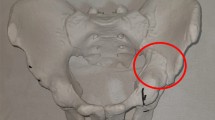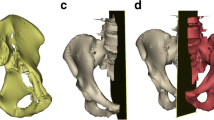Abstract
Purpose
To compare the outcomes of the Kocher-Langenbeck reduction and fixation of the posterior structures of the acetabulum between 3D printing technique and conventional technique.
Methods
Forty-three patients who sustained fractures of the posterior part of the acetabulum were randomly assigned to two groups: 3D printing (G1; n = 20) and conventional technique (G2; n = 23). The surgical time, intra-operative blood loss, differences between pre-and post-operative haemoglobin, universal functional and radiographic scores, and complications were compared between the groups. The minimum follow-up was 18 months.
Results
The average operating time (120.75 min) and intra-operative blood loss (244 ml) were lower in G1 than in G2 (125.87 min and 268.7 ml, respectively; p = 0.42, p = 0.1, respectively). The difference between the pre- and post-operative haemoglobin was 1.71 g/dl in G1 and 1.93 g/dl in G2 (p = 0.113).
Post-operative complications occurred more frequently in patients in G2 (34.7%) than in patients in G1 (15%), though these differences were also not significant (p = 0.6). The radiographic result was satisfactory in 16 patients (80%) in G1 and 18 patients (78.26%) in G2 (p = 0.5). The clinical result was satisfactory in 15 patients (75%) in G1 and in 17 patients (73.9%) in G2 (p = 0.6).
Conclusions
No significant differences were found in terms of surgical time, overall complications, and radiographic or functional outcomes between 3D printing and the conventional technique.





Similar content being viewed by others
References
Bagaria V, Chaudhary K (2017) A paradigm shift in surgical planning and simulation using 3Dgraphy: experience of first 50 surgeries done using 3D-printed biomodels. Injury 48(11):25012–25508. https://doi.org/10.1016/j.injury.2017.08.058
Beredjiklian PK, Wang M, Lutsky K, Vaccaro A, Rivlin M (2020) Three-dimensional printing in orthopaedic surgery: technology and clinical applications. J Bone Joint Surg Am 102(10):909–919. https://doi.org/10.2106/jbjs.19.00877
Alton TB, Gee AO (2014) Classifications in brief: Letournel classification for acetabular fractures. Clin Orthop Relat 472(1):35–38. https://doi.org/10.1007/s11999-013-3375-y
Ovre S, Sandvik L, Madsen JE, Roise O (2007) Modification of the Harris Hip Score in acetabular fracture treatment. Injury 38(3):344–349. https://doi.org/10.1016/j.injury.2006.04.129
Matta JM (1996) Fractures of the acetabulum: accuracy of reduction and clinical results in patients managed operatively within three weeks after the injury. J Bone Joint Surg Am 78(11):1632–1645
Upex P, Jouffroy P, Riouallon G (2017) Application of 3D printing for treating fractures of both columns of the acetabulum: benefit of pre-contouring plates on the mirrored healthy pelvis. Orthop Traumatol Surg Res 103(3):331–334. https://doi.org/10.1016/j.otsr.2016.11.021
Wong KC (2016) 3D-printed patient-specific applications in orthopedics. Orthop Res Rev 14(8):57–66. https://doi.org/10.2147/ORR.S99614
Boulay C, Tardieu C, Bénaim C, Hecquet J, Marty C, Prat-Pradal D et al (2006) Three-dimensional study of pelvic asymmetry on anatomical specimens and its clinical perspectives. J Anat 208(1):21–33. https://doi.org/10.1111/j.1469-7580.2006.00513.x
Cimerman M, Kristan A, Jug M, Tomaževič M (2021) Fractures of the acetabulum: from yesterday to tomorrow. Int Orthop 45(4):1057–1064. https://doi.org/10.1007/s00264-020-04806-4
Boudissa M, Noblet B, Bahl G, Oliveri H, Herteleer M, Tonetti J et al (2021) Planning acetabular fracture reduction using a patient-specific biomechanical model: a prospective and comparative clinical study. Int J Comput Assist Radiol Surg 16(8):1305–1317. https://doi.org/10.1007/s11548-021-02352-x
IJpma FFA, Meesters AML, Merema BBJ, ten Duis K, deVries JPPM, Banierink H et al (2021) Feasibility of imaging-based 3-dimensional models to design patient-specific osteosynthesis plates and drilling guides. JAMA Netw Open 4(2):e2037519. https://doi.org/10.1001/jamanetworkopen.2020.37519
Fang C, Cai H, Kuong E, Chui E, Siu YC, Ji T et al (2019) Surgical applications of three-dimensional printing in the pelvis and acetabulum: from models and tools to implants. Unfallchirurg 122(4):278–285. https://doi.org/10.1007/s00113-019-0626-8
Downey C, McCarrick C, Fenelon C, Murphy EP, O’Daly BJ, Leonard M (2020) A novel approach using 3-D printing in the Irish National Centre for pelvic and acetabular surgery. Ir J Med Sci 189(1):219–228. https://doi.org/10.1007/s11845-019-02055-y
Chen C, Cai L, Zheng W, Wang J, Guo X, Che H (2019) The efficacy of using 3D printing models in the treatment of fractures: a randomized clinical trial. BMC Musculoskel Disord 20(65). https://doi.org/10.1186/s12891-019-2448-9
Chen K, Yang F, Yao S, Xiong Z, Sun T, Zhu F et al (2019) Application of computer-assisted virtual surgical procedures and three-dimensional printing of patient-specific pre-contoured plates in bicolumnar acetabular fracture fixation. Orthop Traumatol Surg Res 105(5):877–884. https://doi.org/10.1016/j.otsr.2019.05.011
Jiang M, Chen G, Coles-Black J, Chuen J, Hardidge A (2020) Three-dimensional printing in orthopaedic preoperative planning improves intraoperative metrics: a systematic review. ANZ J Surg 90(3):243–250. https://doi.org/10.1111/ans.15549
Chana-Rodríguez F, Mañanes RP, Rojo-Manaute J, Gil P, Martínez-Gómiz JM, Vaquero-Martín J (2016) 3D surgical printing and pre contoured plates for acetabular fractures. Injury 47(11):2507–2511. https://doi.org/10.1016/j.injury.2016.08.027
Hsu CL, Chou YC, Li YT, Chen JE, Hung CC, Wu CC et al (2019) Pre-operative virtual simulation and three-dimensional printing techniques for the surgical management of acetabular fractures. Int Orthop 43(8):1969–1976. https://doi.org/10.1007/s00264-018-4111-8
Tu DP, Yu YK, Liu Z, Zhang WK, Fan X, Xu C (2021) Three-dimensional printing combined with open reduction and internal fixation versus open reduction and internal fixation in the treatment of acetabular fractures: a systematic review and meta-analysis. Chin J Traumatol 24(3):159–168. https://doi.org/10.1016/j.cjtee.2021.02.007
Kim JW, Lee Y, Seo J, Park JH, Seo YM, Kim SS et al (2018) Clinical experience with three-dimensional printing techniques in orthopedic trauma. J Orthop Sci 23(2):383–388. https://doi.org/10.1016/j.jos.2017.12.010
Morgan C, Khatri C, Hanna SA, Ashrafian H, Sarraf KM (2020) Use of three-dimensional printing in preoperative planning in orthopaedic trauma surgery: a systematic review and meta-analysis. World J Orthop 11(1):57–67. https://doi.org/10.5312/wjo.v11.i1.57
Cao J, Zhu H, Gao Ch (2021) A systematic review and meta-analysis of 3D printing technology for the treatment of acetabular fractures. Biomed Res Int. https://doi.org/10.1155/2021/5018791
Wang C, Chen Y, Wang L, Wang D, Gu C, Lin X et al (2020) Three-dimensional printing of patient specific plates for the treatment of acetabular fractures involving quadrilateral plate disruption. BMC Musculoskelet Disord 21(451). https://doi.org/10.1186/s12891-020-03370-7
Wang P, Kandemir U, Zhang B, Fei C, Zhuang Y, Zhang K (2021) The effect of new preoperative preparation method compared to conventional method in complex acetabular fractures: minimum 2-year follow-up. Arch Orthop Trauma Surg 141(2):215–222. https://doi.org/10.1007/s00402-020-03472-w
Maini L, Verma T, Sharma A, Sharma A, Mishra A, Jha S (2018) Evaluation of accuracy of virtual surgical planning for patient-specific pre-contoured plate in acetabular fracture fixation. Arch Orthop Trauma 138(4):495–504. https://doi.org/10.1007/s00402-018-2868-2
Wu HY, Shao QP, Song CJ, Shang RR, Liu XM, Cai XH (2020) Personalized three-dimensional printed anterior titanium plate to treat double-column acetabular fractures: a retrospective case-control study. Orthop Surg 12(4):1212–1222. https://doi.org/10.1111/os.12741
Huang JH, Liao H, Tan XY, Xing WR, Zhou Q, Zheng YS et al (2020) Surgical treatment for both-column acetabular fractures using pre-operative virtual simulation and three-dimensional printing techniques. Chin Med J (Engl) 133(4):395–401. https://doi.org/10.1097/cm9.0000000000000649
Wen X, Huang H, Wang C, Dong J, Lin X, Huang F et al (2020) Comparative biomechanical testing of customized three-dimensional printing acetabular-wing plates for complex acetabular fractures. Adv Clin Exp Med 29(4):459–468. https://doi.org/10.17219/acem/116749
Yammine K, Karbala J, Maalouf A, Daher J, Assi C (2021) Clinical outcomes of the use of 3D printing models in fracture management: a meta-analysis of randomized studies. Eur J Trauma Emerg Surg. https://doi.org/10.1007/s00068-021-01758-1
Zhuang Y, Cao S, Lin Y, Li R, Wang G, Wang Y (2016) Minimally invasive plate osteosynthesis of acetabular anterior column fractures using the two-incision minimally invasive approach and a preshaped three dimension plate. Int Orthop 40(10):2157–2162. https://doi.org/10.1007/s00264-015-3111-1
Awan OA, Sheth M, Sullivan I, Hussain J, Jonnalagadda P, Ling S et al (2018) Efficacy of 3D printed models on resident learning and understanding of common acetabular fractures. Acad Radiol 26(1):130–135. https://doi.org/10.1016/j.acra.2018.06.012
Lim PK, Stephenson GS, Keown TW, Byrne C, Lin CC, Marecek GS et al (2018) Use of 3D printed models in resident education for the classification of acetabulum fractures. J Surg Educ 75(6):16791–17684. https://doi.org/10.1016/j.jsurg.2018.04.019
Manganaro MS, Morag Y, Weadock WJ, Yablon CM, Gaetke-Udager K, Stein EB (2017) Creating three-dimensional printed models of acetabular fractures for use as educational tools. Radiographics 37(3):871–880. https://doi.org/10.1148/rg.2017160129
Huang Z, Song W, Zhang Y, Zhang Q, Zhou D, Zhou X et al (2018) Three-dimensional printing model improves morphological understanding in acetabular fracture learning: a multicenter, randomized, controlled study. PLoS ONE. https://doi.org/10.1371/journal.pone.0191328
Preece D, Williams SB, Lam R, Weller R (2013) “Let’s get physical”: advantages of a physical model over 3D computer models and textbooks in learning imaging anatomy. Anat Sci Educ 6(4):216–224. https://doi.org/10.1002/ase.1345
Weidert S, Andress S, Linhart C, Suero EM, Greiner A, Böcker W et al (2020) 3D printing method for next-day acetabular fracture surgery using a surface filtering pipeline: feasibility and 1-year clinical results. Int J Comput Assist Radiol Surg 15(3):565–575. https://doi.org/10.1007/s11548-019-02110-0
Acknowledgements
We would like to thank MD Thierno Sadou Barry (Biostatistician at Public health of the Dalaba Prefecture Hospital-Guinea) for the statistical analysis. Furthermore, we would like to thank Pr Philippe Rosset (Trousseau University Hospital of Tours-France) and MD Pomme Jouffroy (Groupe Hospitalier Paris Saint Joseph, Paris-France) for their valuable and constructive suggestions during the planning of this study.
Author information
Authors and Affiliations
Contributions
All authors contributed to the study conception and design.
Mohamed Bouabdellah: conceptualization, (study design) methodology, writing – original draft, review editing, supervision, validation.
Mohamed Bensalah: conceptualization, investigation, data curation.
Chrif Kamoun: literature search, data and formal analysis.
Mehdi Bellil: literature search, software.
Mondher Kooli: (study design) methodology, review editing, validation.
Khaled Hadhri: funding acquisition, visualisation.
All authors read and approved the final manuscript.
Corresponding author
Ethics declarations
Ethics approval
The manuscript was approved by the ethics committee of Charles Nicolle Hospital of Tunis.
The study was conducted in accordance with the Declaration of Helsinki. Informed consent was obtained from all patients. This study was registered on https://clinicaltrials.gov/ct2/show/NCT04660734
Consent to participate
All participants provided verbal and written informed consent.
Consent for publication
The authors affirm that human research participants provided informed consent for the publication of the images in Fig. 4.
Conflict of interest
The authors declare no competing interests.
Additional information
Publisher’s note
Springer Nature remains neutral with regard to jurisdictional claims in published maps and institutional affiliations.
Rights and permissions
About this article
Cite this article
Bouabdellah, M., Bensalah, M., Kamoun, C. et al. Advantages of three-dimensional printing in the management of acetabular fracture fixed by the Kocher-Langenbeck approach: randomised controlled trial. International Orthopaedics (SICOT) 46, 1155–1163 (2022). https://doi.org/10.1007/s00264-022-05319-y
Received:
Accepted:
Published:
Issue Date:
DOI: https://doi.org/10.1007/s00264-022-05319-y




